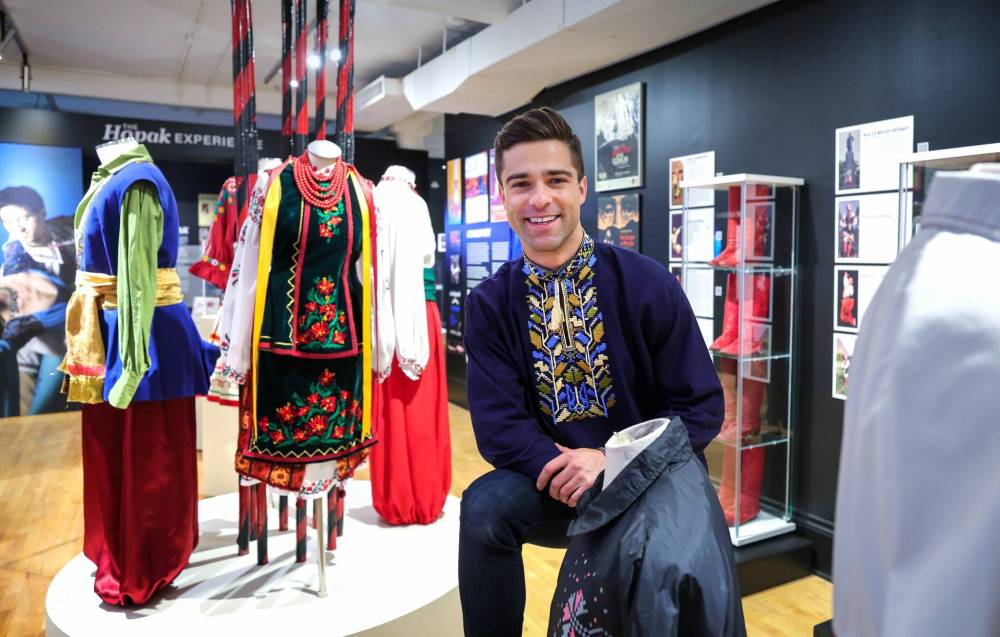
Through colourful costumes, archival videos, photographs and red leather boots, The Journey Through Ukrainian Dance celebrates the 60-year history of Winnipeg’s Rusalka Ukrainian Dance Ensemble.
Exhibition preview
The Journey Through Ukrainian Dance
- Opens Monday, runs to Sept. 30
- Oseredok Ukrainian Cultural and Educational Centre, 184 Alexander Ave.
- Gallery open Monday to Saturday, 10 a.m. to 4 p.m.
- Free admission; visit oseredok.ca for more information
Preparing the gallery show, which opens to the public Monday at the Oseredok Ukrainian Cultural and Educational Centre., has also been a personal journey for first-time curator Markian Tarasiuk.
“My dad has been involved with this group for basically its entire history,” Tarasiuk says of his father and collaborator Myron Tarasiuk. “This project has been defining for me, in terms of my heritage, and it gets to connect me more to… my father because I get to work with him and learn from him.”
Tarasiuk, 30, started taking Ukrainian dance lessons at four years old and auditioned for Rusalka when he turned 16. Joining the group was a familial rite of passage.
“It felt like Rusalka was always part of my life,” he says. “My parents met in Rusalka; so did my sister and her now-husband.”
Beyond acting as an unofficial matchmaking service, the high-calibre dance troupe has been an important source of community and cultural pride for members of Winnipeg’s Ukrainian community.
Founded in October 1962 by Peter Hladun, Rusalka performs traditional folk dances from 15 different region of Ukraine locally and across the world.

A highlight of Tarasiuk’s four-year career with the ensemble was the response from audiences during a performance tour in Ukraine.
“I’ll never forget how gobsmacked these Ukrainians were that a group from Canada of a bunch of second- and third-generation kids were doing Ukrainian dance for them in their own country,” he says. “We’ve kept up this ancient tradition and have done a darn good job of it.”
The Journey exhibit was born out of a commemorative coffee-table book, entitled Rusalka: The Legend and the Legacy, which the father-and-son duo created for the group in 2019.
That project involved sifting through boxes of historic materials stored haphazardly at the Ukrainian National Federation (UNF), the longtime Main Street home of Rusalka.
Since the book’s release, Myron has been busy organizing the materials for an official archive hosted at Oseredok.
“It’s an anniversary year for the group,” the younger Tarasiuk says. “But it’s also the timing of the extensive archival work that’s been done, and this is our time to display it before we put it away in boxes for a long time.”

Putting together a full-scale exhibition was a first for the actor and multidisciplinary artist, who currently lives in Los Angeles. Tarasiuk has spent the last two years working with the team at Oseredok from afar and has been in Winnipeg since the beginning of May, preparing for the exhibit’s launch.
“I’ve been a fan of museums my whole life and until you do it yourself, you don’t understand what goes into it,” he says. “Every single detail needs to be thought about… and hopefully it looks effortless.”
Journey is broken up into sections that speak to Rusalka’s history, beginning with a room dedicated to the UNF building, where the ensemble and its associated dance school train. There’s a vintage piano and scribbled-on school desk opposite a large video screen showing black-and-white video of a rehearsal. A mirror and ballet barre are available for visitors to test their skills. The exhibit is designed to be immersive.
A hall highlighting different regional dance styles and costumes opens into a space emblematic of the Rusalka experience. In one section, Tarasiuk attempted to recreate the group’s costume closet — smell and all.
“It brings you right into the feeling of it,” he says, laughing and wafting the air with his hand. “It’s a very specific Rusalka experience to go up there and try on your costumes.”

On another wall is a display of a dozen red leather boots in various states of wear. Tarasiuk reached out to Rusalka alums to share their boots and their favourite memories of wearing the iconic bit of costuming.
While Journey is a celebration of a local cultural institution, it arrives at a difficult moment in Ukrainian history.
“This is what Russia is trying to erase right now,” Tarasiuk says, adding that the exhibit’s curation took on a heavier tone amid Russia’s war in Ukraine. “We’re fighting across the world to just keep this alive.”
How to approach the wider political context of the exhibit was a point of conversation among Tarasiuk, Rusalka and Oseredok.
“I think for both of our organizations, where we settled was that it’s really important to celebrate the fact that Ukrainian identity is distinct from other European national identities… it’s something we want to recognize now more than ever,” says Alexandra Shkandrij, Oseredok’s curator of exhibits. “Dance is an incredibly important part of that Ukrainian culture.”
This is the second time Oseredok has hosted an exhibit on Rusalka — the last took place 35 years ago.
“So much has happened in those 35 years,” Shkandrij says. “The organization has really been reborn.”

During the Free Press’s visit, the East Exchange District centre was hosting a language class for Ukrainian immigrants displaced by the war. The wave of new residents has injected new purpose into both Oseredok and the UNF hall, which has once again become a gathering place for Winnipeg’s Ukrainian community.
“That hall has been so influential and now it’s had a huge resurgence,” says Tarasiuk, who spent much of his childhood in the space. “The place is bumping again, which is great to see.”
The Journey Through Ukrainian Dance exhibit runs until September, after which Rusalka will be hosting a local dance showcase to close out its 60th anniversary year. Voda — A Rusalka Story will feature new music and choreography based on the cultural significance of water. The performance takes place Oct. 14 at Club Regent Event Centre.
Twitter: @evawasney
If you value coverage of Manitoba’s arts scene, help us do more.
Your contribution of $10, $25 or more will allow the Free Press to deepen our reporting on theatre, dance, music and galleries while also ensuring the broadest possible audience can access our arts journalism.
BECOME AN ARTS JOURNALISM SUPPORTER
Click here to learn more about the project.



